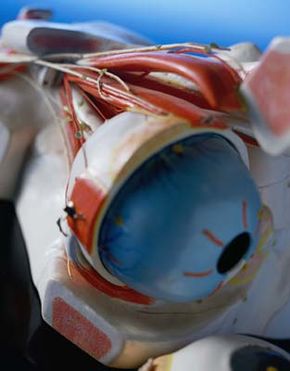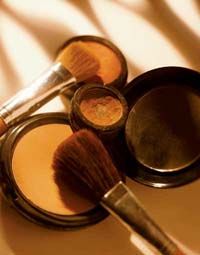Unfortunately, there are some eye disorders that people are born with, and there is no amount of prevention that will prevent the symptoms. Here are a few of the major ones:
Astigmatism
Astigmatism is a type of distorted vision caused by a defect in the curvature of the cornea or lens of the eye. Most people with astigmatism can see clearly those objects directly in front of them, but their peripheral vision -- perhaps above and below, or to the right and left sides, or diagonally -- is defective.
Usually, prescription eyewear corrects the problem. Most people with astigmatism were born with the tendency, but it can also be caused by eye disease or injury. The latter type is more difficult to correct. Regardless of the cause, early treatment is crucial. Children, in particular, might be at risk of permanently defective vision if astigmatism isn't corrected early.
Cataract
A cataract is a clouding of the lens of the eye that results in obscured vision. People with this defect see their environment as if they were looking through a waterfall -- hence the name of the disease. Other symptoms include
- sensitivity to light and glare
- fading or yellowing of colors
- poor night vision
- halos around lights
The exact cause of cataracts is unknown. Aging probably plays a role. About half of Americans between ages 65 and 74 have cataracts, with that portion jumping to 70 percent in people older than 75. But cataracts can also occur in young people, even newborns whose mothers contracted German measles during pregnancy.
There is ongoing research to determine whether certain vitamins and minerals might help prevent or slow down the development of cataracts. Injury to the lens, prolonged use of corticosteroid drugs, and high doses of radiation (such as X rays) may also trigger the condition. Overexposure to ultraviolet rays, a part of sunlight, also boosts the risk of cataracts.
Although usually curable, cataracts can lead to blindness if untreated. When necessary, surgical treatment restores vision in 95 percent of cataract operations. The procedure is usually done on an outpatient basis. Surgery is performed, however, only when the cataracts are interfering with daily living.
Years ago, patients had to wear special glasses with thick lenses after cataract surgery -- no longer. Now surgeons usually implant an intraocular lens, a tiny lightweight plastic disk, that produces an undistorted image. There is one shortcoming: Because it's not a natural lens, it can't adjust for focusing on near and distant images. Doctor and patient must decide before surgery which correction to choose.
Glaucoma
Glaucoma is an eye disorder caused by increased pressure within the eyeball, which builds up because fluids are unable to drain normally. The disorder is most common in people over 40 years of age; it's a leading cause of blindness in people over 60.
About 90 percent of glaucoma is the chronic form, in which pressure builds gradually, undetected for years. In a much rarer type, acute glaucoma, pressure mounts suddenly, bringing severe pain and abrupt vision blurring.
Vision deterioration in chronic glaucoma is so gradual and painless that it's been termed the sneak thief of sight. Sometimes loss of peripheral vision slowly progresses, while central vision remains normal. Other later symptoms include
- foggy or blurred vision; peripheral vision is usually affected first
- difficulty in adjusting to brightness and darkness
- slight pain in or around the eye
- a halo effect around distant lights
But by the time symptoms appear, chronic glaucoma may already have done permanent damage. That's why regular screening after age 40 is essential to identify the disease early. Early treatment can slow damage to the eyes and prevent further vision loss.
You are at higher risk for glaucoma if you
- are black
- have diabetes
- have had a previous eye injury
- have a family history of glaucoma
- have been a long-term user of corticosteroid drugs
People at high risk should get an exam at least once every two years. Others should be examined every three to five years.
If detected early, glaucoma usually can be controlled with eyedrops, which sometimes have side effects of drowsiness, blurry vision, headache, or changes in heart rate. Laser surgery can be used when medications don't work well, but a 1996 study concluded that laser surgery, as a first-line therapy, works as well as eyedrops and has fewer side effects. However, the effect of laser surgery can wear off with time, and additional treatment may be necessary.
Myopia
When the eyeball is too long from front to back or the cornea is too curved, the result can be myopia, better known as nearsightedness. People with myopia can see close objects clearly, but objects at a distance look blurry. In normal vision, the image of a distant object gets focused on the retina, but in myopia, because of the greater length of the eyeball, the focused image falls short of the retina. The result: a fuzzy image.
Myopia tends to be hereditary, developing at around age 12 and progressing until about age 20. Rarely does the condition get any worse after age 30 and, in fact, sometimes it improves after that age.
Eyeglasses or contact lenses easily correct nearsightedness. People who don't want to bother with either types of eyewear might consider radial keratotomy. This is a surgical procedure that involves cutting a number of spokes into the corneal surface, thus altering the shape of the cornea and correcting nearsightedness.
In 1994, ophthalmologists released the first long-term study on radial keratotomy, funded by the National Eye Institute. Results showed that 70 percent of people who'd had radial keratotomy didn't need to wear corrective lenses 10 years after surgery.
Radial keratotomy doesn't work for everyone, and there are risks, such as poor reading vision or poor night vision. People who are the best candidates for the procedure are those who are only mildly nearsighted. Anyone considering the surgery should fully discuss the expected results and possible complications with an ophthalmologist. A new procedure, called photorefractive keratotomy, is also available.
Most eye problems, thankfully, are only temporary, and they will clear up with the proper treatment. For more information on temporary eye conditions, turn to the next section.
This information is solely for informational purposes. IT IS NOT INTENDED TO PROVIDE MEDICAL ADVICE. Neither the Editors of Consumer Guide (R), Publications International, Ltd., the author nor publisher take responsibility for any possible consequences from any treatment, procedure, exercise, dietary modification, action or application of medication which results from reading or following the information contained in this information. The publication of this information does not constitute the practice of medicine, and this information does not replace the advice of your physician or other health care provider. Before undertaking any course of treatment, the reader must seek the advice of their physician or other health care provider.



